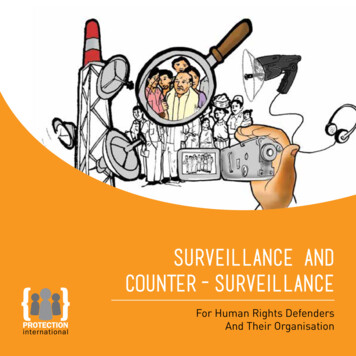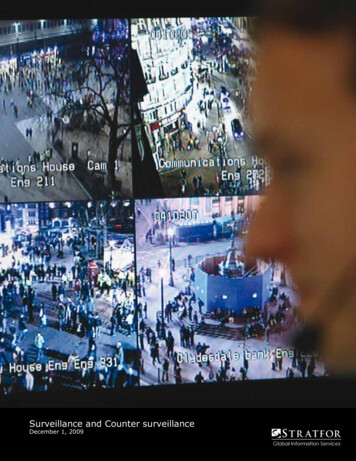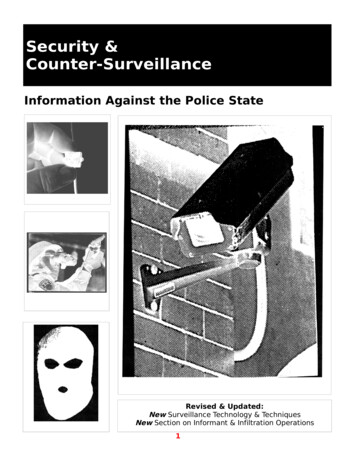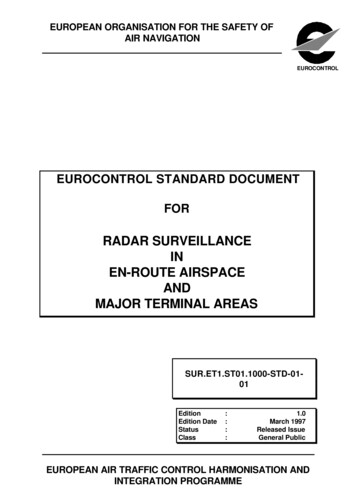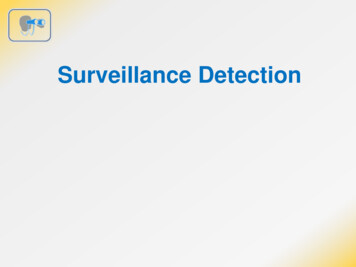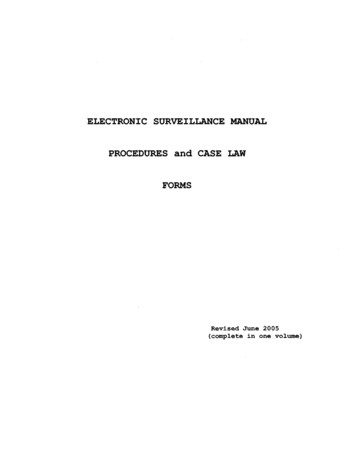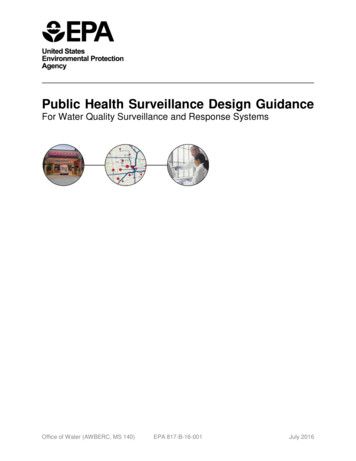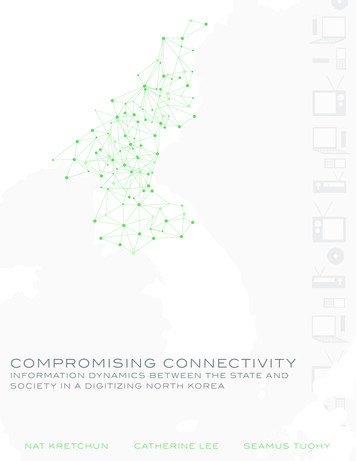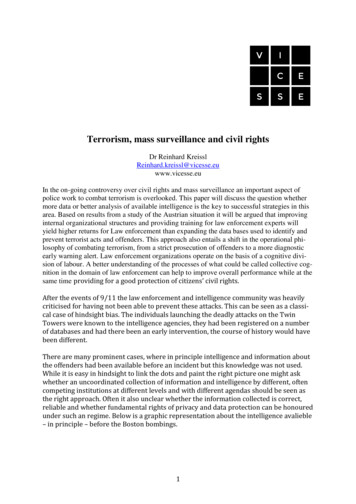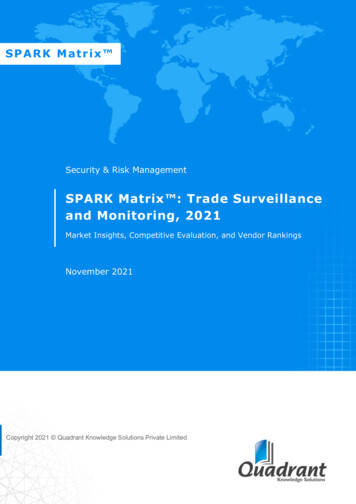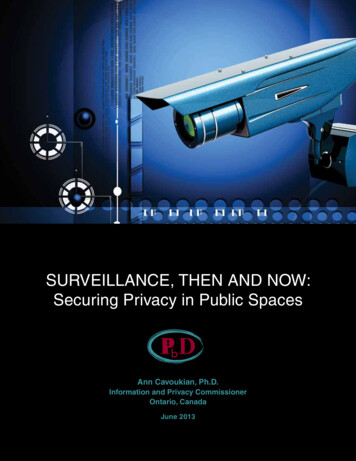
Transcription
SURVEILLANCE, THEN AND NOW:Securing Privacy in Public SpacesAnn Cavoukian, Ph.D.Information and Privacy CommissionerOntario, CanadaJune 2013
AcknowledgementsI would like to express my deepest appreciation to Stephen McCammonfor all his hard work and dedication! His invaluable contributions werevital in giving this paper life.I would also like to recognize Hannah Draper for her tireless efforts andJenny Ryu for her support in preparing this paper.Information and PrivacyCommissioner,Ontario, Canada2 Bloor Street EastSuite 1400Toronto, OntarioM4W 1A8Canada416-326-33331-800-387-0073Fax: 416-325-9195TTY (Teletypewriter): 416-325-7539Website: www.ipc.on.caPrivacy by Design: www.privacybydesign.ca
Table of ContentsExecutive Summary1Commissioner’s Foreword5Introduction7Part I – The Importance of Privacy9Part II – Looking Back12Securing Privacy in Government’s Information-Handling Practices12Securing Privacy in Private Communications and Activities14Part III – Current ChallengesSecuring Privacy in the Online and Digital World1818In the United Kingdom19In the United States20In Canada21Part IV – Meeting the Future Head OnSecuring the Right to Privacy in Public Spaces2323Automatic Licence Plate Recognition Systems26Video Surveillance and CCTV Cameras31Geolocational Tracking38DRONES: Drone-based Surveillance41Conclusions49Endnotes50
Executive SummarySurveillance is growing, as are the technologies that extend its reach. But surveillance thatfacilitates the sustained monitoring of people engaged in everyday activities in public is, inJustice Gérard La Forest’s unforgettable words, “an unthinkable prospect in a free and open societysuch as ours.”1Unthinkable as it may be, the prospect of close and continuous surveillance is no longer simplythe stuff of science fiction. Governments now have access to precise and affordable technologiescapable of facilitating broad programs of indiscriminate monitoring. The unfettered use of thesetechnologies raises the spectre of a true surveillance state. To freedom-loving people, that is anunacceptable prospect.The purpose of this paper is to assist law enforcement, lawmakers, and the broader public inunderstanding and protecting our fundamental right to privacy with respect to surveillance by thestate of our activities in public spaces through the use of ever-growing new technologies.Of course, our expectation of privacy in public spaces is lower than in private places. However, itis not entirely eliminated. Let us remember that the right to privacy protects people, not places.In addition, as governments consider the implications of recent terrorism-related developmentsin Canada and the United States, we must consider that new technologies may be able to provideincreased efficiencies for law enforcement and their performance of vital public safety functions.How can free and democratic societies ensure that the public receives the benefits associatedwith these new technologies, while continuing to provide strong privacy protections? To secureour right to privacy in public, in an era of explosive new technologies, requires a proactiveapproach that emphasizes the right to informational privacy owed to all citizens. The true valueof privacy must be recognized, and ideally enhanced, not diminished, in any effort to modernizelaw enforcement powers.A proactive Privacy by Design approach is central to designing and implementing the regulatoryframework needed to properly supervise state surveillance. It is our experience that, where the useof a particular surveillance technology is justified, proportionate, and effective at delivering publicsafety, a proactive positive-sum approach is available that will ensure that privacy, accountability,and transparency are embedded into the legal and technical design specifications of any proposedsurveillance system.–1–
In an effort to encourage a proactive approach to the use and supervision of the next generation ofsurveillance technologies, this paper examines the following: The vital importance of privacy to freedom and liberty (Part I); How we came to secure privacy in government’s information-handling practices, as well as inour private communications and activities (Part II); and A range of the current challenges to securing privacy in the online and digital world (Part III).What emerges from this study is a set of 10 principles that we apply to law enforcement’s use offour emerging surveillance technologies: video surveillance cameras and closed circuit television(CCTV), automatic licence plate recognition systems, geolocational tracking, and drone-basedsurveillance (Part IV).One of the crucial principles is that the police power to deploy any form of intrusive surveillancetechnology must be supervised under a system of prior judicial authorization. The importance of thispoint cannot be overemphasized. Unfettered law enforcement access to surveillance technologiesthat are capable of facilitating indiscriminate monitoring threatens our right to a reasonableexpectation of privacy, particularly where that monitoring may be continuous and persistent.At the same time, not all surveillance programs are equally intrusive. For example, it is possible thatsurveillance may be effective without being persistent or penetrating. Nonetheless, with respectto the deployment of any surveillance technology, what will be required is the right mix of legal,administrative and technical controls to ensure that their use is appropriate and accountable.This paper sets out what we believe to be the controls necessary to ensure the appropriate andaccountable use of CCTV video surveillance cameras, automatic licence plate recognition systems,geolocational tracking, and drone-based surveillance. Those controls include open, accountable andproportionate information-handling practices that are subject to independent scrutiny, includingthrough notification and reporting requirements.Whatever the future holds, we know that, in addition to privacy and freedom, people will requiresafety and security. We believe that now, and for the foreseeable future, it is essential that we striveto have both, in tandem. Freedom must be preserved from both terrorism and tyranny. Whileeternal vigilance will be required to secure our fundamental rights, including our right to privacy,we remain confident that we can have both public safety and personal privacy in public spaces.There is neither reason, nor need, to settle for anything less.In summary, our approach to the proper supervision of law enforcement’s use of new and emergingsurveillance technologies is based upon the following key principles:–2–
Privacy Principles in Public Spaces1. Data-gathering by the state should be restricted to that whichis reasonably necessary to meet legitimate social objectives, andsubjected to controls over its retention, subsequent use, and disclosure.2. The state should be open and accountable for its informationhandling practices.3. Compliance with privacy rules and restrictions should be subject toindependent scrutiny.4. The authority to employ intrusive surveillance powers shouldgenerally be restricted to limited classes of individuals such aspolice officers.5. The police power to deploy any form of intrusive surveillance mustbe supervised under a system of prior judicial authorization.6. Even where genuine emergencies make it impracticable for the policeto obtain judicial authorization before they employ surveillancemeasures, the state must remain transparent and accountablefor its use of intrusive powers through subsequent, timely, andindependent scrutiny of their use.7. A positive-sum approach to designing a regulatory frameworkgoverning state surveillance can avoid false dichotomies andunnecessary trade-offs, demonstrating that it is indeed possible tohave both public safety and personal privacy. We can and must haveboth effective law enforcement and rigorous privacy protections.8. Close attention must be paid to the privacy impact of newtechnologies, business practices, and police tactics if we are tocontinue to ensure strong, principle-based privacy protections.9. Surveillance practices that intrude upon privacy by leveragingnew technological platforms or transmission processes must bescrutinized to ensure that they are accompanied by sufficientlyrigorous privacy and accountability protections.10. Eternal vigilance will be required to secure our fundamental rights,including the right to personal privacy in relation to all publicspaces, including those found online and in other virtual spaces.–3–
Commissioner’s ForewordAs we all adjust to the tragic bombings at the Boston Marathon, followed by the thwarted plotto derail a VIA Rail passenger train travelling between Toronto and New York, and the flurryof terrorism-related charges that ensued, it is critical that citizens of free and democratic societiesraise their voices in support of those committed to achieving both security and privacy.In this climate, the authorities in multiple jurisdictions, including the United States, will be underenormous pressure to overreact. Some officials are already arguing that they need “an enhanced abilityto monitor public places.”2 Others have even suggested that, post-Boston, “privacy is overrated.”3 Ofcourse, reasonable proposals to achieve real improvements in public safety should be welcomed, butthe notion that we should somehow dispense with privacy protections is clearly excessive.Proposals to obtain security at any cost must be resisted. In the drive for unattainably perfectsecurity, we will invariably experience the real loss of privacy and freedom. As Benjamin Franklin,one of the founding fathers of the United States, wisely observed, “They that can give up essentialliberty to obtain a little temporary safety, deserve neither liberty nor safety.”4I believe we must continue to seek measures designed to provide both security and privacy, in anaccountable and transparent manner. Whether the issue is one relating to cybersecurity legislationor surveillance technologies ranging from CCTV cameras to biometrics, to automatic licence platerecognition to drones, we must reject the dated zero-sum, either/or, win/lose approach. By shiftingto a positive-sum mindset focused on win-win solutions, we will be able to accommodate multiplelegitimate interests, thereby avoiding unnecessary trade-offs and false dichotomies.–5–
–6–
Introduction[I]n this era of explosive technology, can it be long before a device is developedthat will be able to track our every movement for indefinite periods evenwithout visual surveillance? This is the time to begin regulating the use ofelectronic tracking devices while they are still in their infancy and before the lawenforcement authorities begin routinely using them as part of their work habits.(R. v. Wise, 1992, Supreme Court of Canada Justice Gérard La Forest)Governments around the world have long used technology to help prevent serious harm andprosecute wrongdoing. Periodically, however, in order to protect our fundamental rightto privacy, lawmakers have had to respond by imposing controls on the use of intrusive newsurveillance techniques. The purpose of this paper is to assist lawmakers, law enforcement, and thebroader public in understanding and protecting our fundamental right to privacy, particularly withrespect to state surveillance of our activities in public spaces using new technologies.By state surveillance, we mean surveillance carried out by the law enforcement agencies responsiblefor investigating, prosecuting, and preventing serious harm. In the discussion that follows, we will bereferring to these agencies using the terms law enforcement, the police, and the state interchangeably.As a regulator with oversight over law enforcement institutions, we have the greatest respect for theimportant work they do. At the same time, as Justice Jackson of the United States Supreme Court“pointed out in [a case dating back to 1948], law enforcement is a competitive enterprise in whichgovernment agents will naturally seek any strategic advantage available to them. Pursuit of thatadvantage naturally impels government agents, acting with the best of intentions, toward broaderand more intrusive forms of surveillance.”5Twenty years have passed since the Supreme Court of Canada first grappled with the police use ofa primitive “beeper” to track a suspect’s car in R. v. Wise;6 nearly 10 years since the Court lookedat police surveillance from an airplane using an unsophisticated infrared radar camera in R. v.Tessling.7 In the meantime, we have seen a significant increase in the state’s capacity for intrusivesurveillance. One emerging issue that raises substantial privacy concerns is the state’s use of dronesfor domestic surveillance. Others include law enforcement’s use of geolocational tracking and–7–
Internet-based surveillance. Left unchecked, such surveillance will have considerable implicationsfor the future of freedom and liberty.Now, more than ever, it is critical that we revisit the way we supervise the state’s use of newsurveillance technologies. Neither a “wait and see” nor an individual “case by case” approach willsuffice. Legislative rules, independent oversight, policy guidance, and administrative and technicalcontrols can all contribute to the protection of privacy. To secure our right to privacy in an era ofexplosive new technologies, however, requires a proactive approach that emphasizes the right toinformational privacy owed to all citizens.The right to informational privacy or data protection includes the individual’s right to exercisea significant measure of control over the collection, use, and disclosure of one’s own personalinformation. In the context of state surveillance, individuals frequently do not have sufficientknowledge and power to effectively control the collection, use, and disclosure of their ownpersonal information by law enforcement. Instead, the right to informational privacy must beprotected by both: (i) the implementation of Privacy by Design8 principles in the design andoperation of legitimate state-deployed surveillance; and (ii) the insistence on legal rules andnorms as found in systems of prior judicial authorization and other systems of independentoversight and accountability. The latter rules and norms are the primary focus of this paper.While special attention will be given to the Canadian context, we also look farther afield atdevelopments in the United States (U.S.) and beyond.Before considering some of the current challenges and emerging technologies, let us first recall theimportant role privacy plays in a free and democratic society, and look back at the emergence ofFIPs-based9 public sector privacy legislation and how we came to regulate some of the early and stillevolving surveillance techniques.–8–
Part I – The Importanceof PrivacyThe protection of privacy is essential to safeguard the “type of society whichCanadians, by the adoption of the Charter, have elected to live in.” Theconstitutional restraints imposed on government limit its power to “pry into thelives of the citizen [and] go to the essence of a democratic state.” Privacyrights and the legal rules supporting them are designed to increase governmentaccountability while leaving individuals secure in the knowledge that “informationcollected by government institutions is relevant to their legitimate programs andoperations.” 10The right to privacy, which has its origins in the recognition of the inherent worth of the individual,plays a central role in the promotion of “respect for individual dignity and autonomy” and the“preservation of a free and democratic society.”11Privacy includes the right to exercise control over one’s own person, personal spaces, and personalinformation. It preserves an “essential space for the development of ethically grounded citizenscapable of engaging in the critical functions of public citizenship.”12 In shielding dissidents andhuman rights advocates, it supports and facilitates freedom of speech and freedom of association.It also helps to ensure freedom from interference and repression.What of the right to privacy in public? “While the expectation of privacy in public spaces maybe lower than in private spaces, it is not entirely eliminated.”13 We must remember that the rightto privacy “protects people, not places.”14 In a 2012 case discussing the right to “public privacy”— a privacy right closely associated with our right to informational privacy — the OntarioCourt of Appeal stated that “personal privacy protects an individual’s ability to function on aday-to-day basis within society while enjoying a degree of anonymity that is essential to theindividual’s personal growth and the flourishing of an open and democratic society.”15 Indeed,in the information and technology era we live in, the protection of our right to informationalprivacy is increasingly critical to the preservation of our rights to life, liberty, and security of theperson — in essence, our freedom.–9–
Properly understood, informational privacy protects our ability to live as both private and socialbeings, secure in the knowledge that the state will not access our personal information or seekto identify us, let alone record and retain our conversations, communications, movements, oractivities, without just cause. These rights are guaranteed under section 8 of the Charter of Rightsand Freedoms (the Charter), which provides that “Everyone has the right to be secure againstunreasonable search or seizure.”16 This right to be secure is not the security or safety interestfrequently invoked as a value weighing against or overriding privacy rights. Like its antecedentin the Fourth Amendment to the U.S. Bill of Rights, the constitutional concept of security thatanimates section 8 of the Charter was born of “the conviction that certain kinds of searches andseizures [are] intolerable.”17Today, both section 8 of the Charter and the Fourth Amendment recognize that everyone hasa right to be secure against the use of unreasonable state powers in the form of unjustifiableand intrusive searches or seizures. As a general rule, this constitutionally mandated securitycan only be provided by ensuring that intrusive powers are subject to timely, exacting, andindependent scrutiny.In addition, privacy legislation such as Ontario’s Freedom of Information and Protection of PrivacyAct (FIPPA) and Municipal Freedom of Information and Protection of Privacy Act (MFIPPA)18ensure that people “have a right to expect the following: that their personal information will onlybe collected for legitimate, limited and specific purposes; that the collection of their personalinformation will be limited to the minimum necessary for the specified purposes; and that theirpersonal information will only be used and disclosed for the specified purposes.”19 In our view,these general principles apply to all public space surveillance systems.Of course, in addition to privacy and freedom, people require safety and security. BenjaminFranklin’s resounding cry from 1775 bears repeating: “They who can give up essential liberty toobtain a little temporary safety, deserve neither liberty nor safety.” This declaration is as relevanttoday as it was then; we believe it is essential that we strive to have both together. We recognize thatfreedom must be preserved from both terrorism and tyranny.And the public clearly recognizes this too. In the aftermath of the Boston Marathon bombings, aTime Magazine poll shows that 61 per cent of Americans are more concerned about the governmentenacting new antiterrorism policies that will excessively restrict civil liberties than they are aboutgovernment going soft on security. Not surprisingly, at a time when private security cameras andpersonal cellphone cameras are always rolling (and considering their role in the quick identificationand capture of the suspected bombers), Americans’ tolerance for video surveillance in public placeshas spiked to a post-9/11 high (81 per cent are now in favour of increased cameras, up from 63 percent). However, there are also indications that there is wariness about enhanced video surveillance.Two weeks after the bombings, support for use of facial recognition technology to scan publicevents has declined from a September 2001 high of 86 per cent to 79 per cent. More telling isthe fact that “Americans are warier than ever about government monitoring of their cell phoneand email communications, with 59 per cent opposed to such actions.” In fact, only 38 per centof Americans favour increased powers with respect to the monitoring of these communications,down from 54 per cent.20– 10 –
Fortunately, we are not faced with the unpalatable and impractical choice of trying to prohibit thestate from using emerging technologies for public safety purposes. By adopting a Privacy by Designframework and imposing legal, administrative, and technical controls to ensure that the use ofsuch technologies is appropriate and accountable, we can accommodate all legitimate interests andobjectives in a positive-sum, win-win manner, not the dated zero-sum model of win/lose, either/or. In this context, it is critical to recall that our approach to wiretapping, video surveillance andother forms of surreptitious electronic surveillance has allowed for necessary and effective lawenforcement while securing the public interest in a reasonable expectation of privacy. Success inachieving a constitutionally appropriate regulatory framework has taken considerable time anddebate, but the lessons learned point to the continuing need for a principled approach in order tosustain not only “peace, order and good government,”21 but freedom and liberty.– 11 –
Part II – Looking BackSecuring Privacy in Government’sInformation-Handling Practices[A] privacy protection policy intended to preserve informational privacy wouldtherefore attempt to restrict personal data-gathering activity to that whichappears to be necessary to meet legitimate social objectives and would attemptto maximize the control that individuals are able to exert over subsequent useand dissemination of information surrendered to institutional records keepers. 22In the years following the adoption of the Charter in 1982, comprehensive FIPs-based public sectorprivacy legislation was enacted across Canada. In one jurisdiction after another, federal andprovincial Parliaments established rules restricting the collection, retention, use, and disclosure ofpersonal information by institutions at all levels of government. These privacy rules also provided forrights of access and correction, complaint mechanisms, and other means of ensuring governmentcompliance with and accountability for privacy requirements. The institutions bound by these rulesinclude police services and a range of other institutions that carry out law enforcement functions.Independent Privacy Commissioners and ombudsmen were established to oversee compliancewith privacy requirements.The public concerns that motivated this wave of legislative activity focused on the fact that, inmany circumstances, individuals were unlikely to have an effective choice to refuse to supply theirpersonal information to the state, information holdings were becoming increasingly extensive, andthere was public anxiety about government agencies sharing their holdings of personal informationand building comprehensive files on individuals.As with criminal law safeguards provided for by prior judicial authorization, FIPs-based privacylegislation was drafted with the intention of preventing privacy harms before they occur. Dataminimization forms a critical component of privacy harm prevention. This principle instructsgovernment not to collect, retain, use, or disclose any more personal information than is reasonablynecessary to meet well-defined, legitimate social objectives.– 12 –
Like the Criminal Code of Canada (“Criminal Code”)23 rules providing for public reporting andafter-the-fact notice with respect to wiretapping, compliance with FIPs-based privacy legislationensures a commitment to openness and accountability. For example, government is generallyrequired to be open about its data-handling practices, ensure the accuracy of its informationholdings, and provide individuals the right to access and request a correction of their personalinformation. In addition, Privacy Commissioners have a role to play in recommending improvedinformation-handling practices to ensure compliance with privacy requirements. Many may alsoorder an institution to comply with privacy requirements.The resulting framework of privacy statutes is not based on a confidentiality analysis in whichprivacy is only protected with respect to information that has been kept secret. Privacy statutesgenerally apply to all personal information collected by government, whether captured on the streetor the Internet.24 Moreover, a government institution’s authority to collect personal information forone purpose does not entitle it to use that same information for a secondary purpose. In addition,while law enforcement officials have been granted exemptions from certain privacy rules,25 theirauthority to collect, use, and disclose personal information must nonetheless fall within the scopeof their law enforcement duties and powers as circumscribed in legislation, under the common law,and by the Charter.The crucial principles to emerge with the rise of privacy legislation: Data-gathering by the stateshould be restricted to that which is reasonably necessary to meet legitimate societal objectives, andsubjected to controls over its retention, subsequent use, and disclosure. The state should be open andaccountable for its information-handling practices. Compliance with privacy rules and restrictionsshould be subject to independent scrutiny.Further consideration will be given to the role of FIPs-based privacy legislation, as well as Privacyby Design, in Part IV of this paper. In the meantime, let us turn to consider how we came to regulatesome of the early and evolving surveillance techniques.– 13 –
Securing Privacy in Private Communicationsand ActivitiesThe right to privacy implies not just freedom from unreasonable search andseizure, but also the ability to identify and challenge such invasions, and toseek a meaningful remedy.(R. v. Tse, 2012, Supreme Court of Canada Justice Rosalie Abella)There is a longstanding relationship between emerging technologies, police surveillance tactics,and the means by which we secure our right to privacy. Throughout this relationship, privacy hasshown itself to be resilient, yet not to be taken for granted, even with respect to privacy in activitiessuch as speaking on the telephone at home. Periodically, we face the challenge of law enforcementwanting a free hand in the use of new or evolving surveillance technologies. In response, we mustensure the proper supervision of their use of powerful new, evolving, and often undetectablesurveillance technologies.Consider, for example, that in Ontario in 1972, the decision to authorize audio surveillance oftelephone conversations was made, not by a court, but by the police. At the same time, wiretappingtechnology had “advanced so rapidly” that the Ontario High Court of Justice recognized that:The apparatus used in snooping devices have been developed in such miniature and deceptiveform that it has become difficult to detect that one is being subjected to its secretive observationor attention. Such listening is not now confined to apparatus directly connected with thetelephone or with wires leading to one’s residence. Devices have been developed that permitlistening in to conversations in a room without any apparatus being installed in the premiseswhatsoever.26While the High Court of Justice identified “a pressing need for legislation in Canada providingprotection to the individual and regulating the area within which such devices may be lawfullyused,” it nonetheless found that, at that time, a person had “no legally enforceable right to theprivacy of his conversation even if held on the telephone.” In this context, the Court was reluctantto “interfere with the judgment of the Police [authority] as to the methods which it feels essentialto meet the task of retaining law and order and suppressing crime.”Since this ruling, the public, governments, and Parliament, as well as the Courts, have given carefulconsideration to the police use of electronic surveillance in the course of their duties, and to theindividual’s right to privacy. Beginning in 1974 and with periodic updates over the ensuing decades,Parliament has laid down a detailed set of rules to both protect privacy in private communicationsand allow for necessary surveillance by the police. Now found in Part VI of the Criminal Code,these rules signal Parliament’s appreciation that “as a general proposition, surreptitious electronicsurveillance of the individual by an agency of the state constitutes an unreasonable search or seizureunder [section] 8 of the Canadian Charter of Rights and Freedoms.”27– 14 –
In Canada, this means the “presumed constitutional standard for searches or seizures in the criminalsphere” is judicial authorization: “a prior determination by a neutral and impartial arbiter, actingjudicially, that the search or seizure is supported by reasonable grounds, established on oath[.]”28In the early 1990s, this principle-based approach to protecting privacy was extended to videosurveillance as well as to “all existing means by which the agencies of the state can electronicallyintrude on the privacy of the individual, and any means which technology places at the disposal oflaw enforcement authorities in the future.” In concluding that all such surveillance must be carefullyregulated, the Supreme Court of Canada emphasized that:[T]here is an important difference between th
surveillance techniques. The purpose of this paper is to assist lawmakers, law enforcement, and the broader public in understanding and protecting our fundamental right to privacy, particularly with respect to state surveillance o
